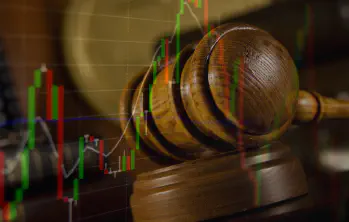Trade surveillance has an integral role in maintaining the integrity and transparency of global markets and a correspondingly significant influence over the compliance and reputation of global financial institutions.
The dynamics aren’t supportive of a business having a static regulatory solution for monitoring trading activity, either, be it digital, in the form of trade surveillance software, or manual. The growing complexity of local market regulation, a response to the evolving threat and sophistication of criminality, continually strengthens the need for effective, adaptable surveillance tools and processes.
What is trade surveillance?
When considering the nuances of trade surveillance, the greater detail, we define it simply as the process of monitoring financial transactions for the presence of suspicious, potentially illegal market abusive activity.
Examples of such activity include insider trading, front running, wash trading, pump and dump, spoofing, and so on through a long list of ever more sophisticated methods, further enhanced by technological advancements.
Regulations enforcing market abuse monitoring
Despite variance in definitions, most global regulators require comprehensive trade surveillance software and processes to be in place and if you’re a financial institution handling securities transactions of any kind then it’s likely you’re included in the ‘must have’ cohort.
MiFID II, MAR, Dodd-Frank, MAS Requirements, and ASIC Market Integrity Rules all legislate for robust defence against market manipulation.
The rise of automated trade surveillance
The sophistication and speed with which asset prices and markets are able to be manipulated has left compliance teams with a moving target when it comes to detection. Manual review is now at best a time-inefficient way to monitor but, in most cases, an automated system is a regulatory requirement, supporting the deployment of trade surveillance software in businesses of varying sizes.
Some surveys point to a shortage of high quality compliance professionals which, along with the blind spots created by manual processes and oversight, and the speed of processing available, supports the need for automation.
The consequences of not having a rigorous trade surveillance system
We are undergoing a significant shift towards much stricter enforcement of market integrity by global financial institutions.
Regulatory penalties range from censure and fines to criminal proceedings, and all carry a direct and often lasting commercial impact.
Outside of the regulatory consequences, the commercial impact of inefficient, or unfit-for-purpose systems and processes is significant, too.
Regulatory or internal, these consequences are avoidable, as we cover below.
What are the options
A common response to this commercial reality is to build your own in-house trade surveillance software solution which is bespoke to the needs of the business and, on the surface, appealing.
But the reality is different.
This involves a business contacting their third-party tech provider – or providers - scoping the required changes, ordering their build, beta, and launch, and then fully implementing.
This comes at a high cost – money and time – and with no guarantee that the end result will be aligned with a regulatory landscape that has shifted throughout the build period.
Adding complexity to the decision-making process, within the bespoke build approach, there are two routes.
The limitations of multiple providers
Firstly, you can adopt a best-of-breed strategy, which involves combining multiple vendors and solutions.
While this approach allows for the implementation of industry-leading solutions for each area, it has commercially limiting aspects. When dealing with multiple vendors, the process can become convoluted, inefficient, and, at times, stressful for the organisation to manage effectively. It is also very difficult to ensure a level of cohesion where data is utilised optimally at every step, and a synchronised process when combining siloed systems.
Develop what you already have
The second strategy involves using but overhauling your incumbent IT resources. This often includes modernising your technology stack, developing new in-house components, integrating existing closed systems, and sometimes performing full-scale rewrites of hard-coded trade surveillance software.
However, this path is not without its challenges. It demands significant time and resource commitments, potentially resulting in delays. Moreover, reshaping existing infrastructure can be challenging when it comes to improving the overall construction to meet the evolving demands and expectations of today’s regulators, and today’s trading behaviour.
Data quality and management is a frictional force. Businesses can find it very difficult to extract relevant data from legacy systems, with much time sunk into cleansing and normalising. Additionally, new communication methods aren’t easily adopted by legacy systems and regulators are ever more concerned with the proliferation and therefore monitoring of new digital communications channels.
The best of all worlds
Third-party trade surveillance software has emerged as an attractive option for financial institutions.
These systems provide a reliable and efficient means of ensuring compliance with a multitude of requirements imposed by various regulatory bodies worldwide.
One of the central advantages lies in the expertise and specialisation of the provider. These systems are meticulously designed and continually updated to align with the latest regulatory changes by a business which, to put it simply, does nothing else but regulatory work and across a wide cross section of the financial sector, ensuring that financial institutions remain ahead of the compliance curve.
Incorporating a new regulatory directive doesn’t involve lengthy project management commitments and unplanned costs from scope creep. Nor does it involve multiple such instances with several trade surveillance software partners. The risk of operating a system that has reached the limit of its customisable functionality and must be replaced is also negated.
Moreover, third-party systems benefit from a depth of experience gained from serving a diverse clientele, allowing them to offer comprehensive solutions that still cater to the unique needs of each institution but also incorporate the best practice firms like Eflow Global see, day in, day out.
Data quality
Data management is critical. To enhance trade surveillance outcomes to an acceptable level, organisations must ensure the accuracy and quality of their data, facilitate comprehensive data aggregation and analysis, establish transparent data lineage, and maintain rigorous records. Working with a partner firm with deep experience in data governance across many financial institutions and across myriad traded instruments is critical.
Training costs
In the UK, the proportion of the compliance budget being spent on staff training and development has dropped from 70% in 2020 to 60% in 2023. 30% is now spent on third-party technology solutions. The positive impact this will have on profit margins will be a compounding one, felt over decades.
Appointing an outsourced provider has the twin benefits of reducing the need for such comprehensive in house training (and indeed hiring) and shifting some training and development burden onto the partner. At Eflow, we take seriously our responsibility in guiding your team on how to work with us.
Scalability
Third-party trade surveillance software is also underpinned by and facilitating of scale.
Seamless interconnection with internal reporting systems mitigates costly manual work, while also acting as a robust safeguard against regulatory risks. Increased trading volumes can be accommodated without the need for rewriting of procedures and costly tech adaptations, and aggressive hiring is not required.
Taking action
The realm of compliance is inherently complex, with regulations often varying by region and evolving over time. It’s natural to feel that there are areas of risk and exposure within your current processes.
The first step is to reach out to a specialist. We offer free consultations which, among other things, will help you gain clarity on what your exact requirements are. From here, the process of selecting a solution becomes much simpler.
By outsourcing this critical aspect of compliance and incorporating third party trade surveillance software into the regulatory processes, financial institutions can not only save valuable time and resources but also tap into the wealth of knowledge and best practices embedded within these systems.
The outcome is a partnership that empowers financial institutions to focus on their core competencies and strategic growth initiatives, knowing that their surveillance needs are handled by a business that will continually be up to speed and that expansion plans do not have to be restricted by compliance considerations.
Please feel free to contact us today to arrange your consultation, and take the first step towards enhancing your trade surveillance.




